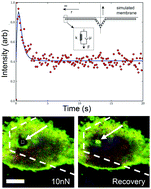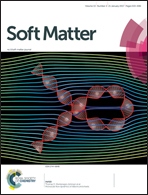Rapid dynamics of cell-shape recovery in response to local deformations†
Abstract
It is vital that cells respond rapidly to mechanical cues within their microenvironment through changes in cell shape and volume, which rely upon the mechanical properties of cells’ highly interconnected cytoskeletal networks and intracellular fluid redistributions. While previous research has largely investigated deformation mechanics, we now focus on the immediate cell-shape recovery response following mechanical perturbation by inducing large, local, and reproducible cellular deformations using AFM. By continuous imaging within the plane of deformation, we characterize the membrane and cortical response of HeLa cells to unloading, and model the recovery via overdamped viscoelastic dynamics. Importantly, the majority (90%) of HeLa cells recover their cell shape in <1 s. Despite actin remodelling on this time scale, we show that cell-shape recovery time is not affected by load duration, nor magnitude for untreated cells. To further explore this rapid recovery response, we expose cells to cytoskeletal destabilizers and osmotic shock conditions, which uncovers the interplay between actin and osmotic pressure. We show that the rapid dynamics of recovery depend crucially on intracellular pressure, and provide strong evidence that cortical actin is the key regulator in the cell-shape recovery processes, in both cancerous and non-cancerous epithelial cells.



 Please wait while we load your content...
Please wait while we load your content...